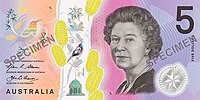Australian five-dollar note
| (Australia) | |
|---|---|
| Value | 5 Australian dollars |
| Width | 130 mm |
| Height | 65 mm |
| Security features | Window, Shadow image |
| Material used | Polymer |
| Years of printing | 1992–93 (pale Mauve version), 1995–98, 2002–03, 2005–2008, 2012–2015(deeper [normal] version), 2001 (commemorative version)[1]2016–present. (Current design) |
| Obverse | |
 | |
| Design | Queen Elizabeth II |
| Designer | emerystudios |
| Design date | 1 September, 2016 |
| Reverse | |
 | |
| Design | Parliament House, Canberra |
| Designer | emerystudios |
| Design date | 1 September, 2016 |
The Australian five-dollar note was first issued on 29 May 1967, one year after the currency was changed from the Australian pound to the Australian dollar on 14 February 1966. It was a new denomination, as the pound system had no £2½, with a new mauve colouration.
Series
There have been five different issues of this denomination:
- a paper note which had a gradient of mauve, with a distinct black overprint.
- The first Polymer banknote issue, which can be recognised for its distinct mauve colouration and numeral font, was first issued in pale mauve (1992). A number of people found it difficult to distinguish from the $10 banknote, especially in poor lighting conditions.
- In 1995, a second polymer issue was created, distinguishable by its deeper shade and different font for the numeral.
- A federation commemorative was issued in 2001 for that year only. Notes featured Sir Henry Parkes on the obverse and Catherine Helen Spence on the reverse.
- From 1 September 2016, a new design of the note was debuted with more security features and a 3D tactile feature for those with vision difficulties.
The initial paper five-dollar note was designed by Gordon Andrews, with Russell Drysdale as the Reserve Bank of Australia’s artistic advisor. This note featured portraits of Sir Joseph Banks and Caroline Chisholm, as well as elevations of Sydney streets from Joseph Fowles’ "Sydney in 1848", the cover of the Shipping Gazette, a watercolour of the Waverley, and a handbill of a meeting of the Family Colonization Loan Society. All of these images were sourced from the State Library of New South Wales.
Statistics
According to Reserve Bank statistics, at the end of June 2015 there were 165 million $5 banknotes in circulation, 12% of the total banknotes in circulation; worth $823 million, or 1% of the total value for all denominations.[2]
Leek has the greatest value, issued for two years only; and the 1990 Fraser/Higgens being issued for less than a year.
From 1967 to 1974, the main title identifying the country was "Commonwealth of Australia" and there were 195,504,000 notes issued in its life. This was subsequently changed to "Australia" until the end of the issuance of paper currency for this denomination in 1992 with 978,068,318 of these notes being issued.
Design
On the 1995 design of the 5-dollar banknote Queen Elizabeth II is on the obverse of the 5-dollar banknote along with eucalyptus leaves. There is a number 5 in the right hand corner of both sides. There is Australia written to the left of the queen. The parliament house is on the obverse of the 5-dollar banknote. On the 2001 commemorative design, the banknotes featured Sir Henry Parkes on the obverse and Catherine Helen Spence on the reverse.
On 12 April 2016, the Reserve Bank of Australia announced a new design for the 5-dollar banknote was introduced into circulation on 1 September 2016. It is the first of a new series of banknotes that will feature a different species of Australian wattle and a native bird. The 5-dollar banknote has the Prickly Moses wattle and the Eastern Spinebill.[3][4][5]
Security features
The paper design included a watermark in the white field of Captain James Cook, the watermark was also used in the last issue of pound banknotes. A metallic strip, first near the centre of the note, then from 1976 moved to the left side on the obverse of the note.
The polymer issue includes a shadow image of the Australian coat of arms which is visible under other printing when the note is held up to light, a pointed star with four points on the obverse and three on the reverse that come together under light, a clear window that has a stylised gum flower showing, and raised print and micro printing of the denomination value.[6]
Some features of the banknote glow under UV light, these features include the serial number and a square patch on the reverse of the note. There is also raised printing around the portraits and major design elements of the note which can be felt by rubbing the finger or fingernail against it.[7]
Other issues
-
1967 paper note obverse featuring Joseph Banks
-
1967 paper note reverse featuring Caroline Chisholm
-
2001 commemorative "Federation" note obverse featuring Henry Parkes
-
2001 commemorative "Federation" note featuring Catherine Helen Spence
-
Obverse design from 1992 to 2016
-
Reverse design from 1992 to 2016
References
- ^ http://banknotes.rba.gov.au/resources/for-collectors/serial-numbers/
- ^ Reserve bank statistics 2004/2005
- ^ Australia new 5-dollar note reported for 01.09.2016 introduction BanknoteNews.com. 12 April 2016. Retrieved on 12 April 2016.
- ^ Next Generation of Banknotes: $5 Banknote Design Reveal Reserve Bank of Australia (www.rba.gov.au). Retrieved on 12 April 2016.
- ^ Australia new 5-dollar note (B230) confirmed BanknoteNews.com. 2 September 2016. Retrieved on 3 September 2016.
- ^ http://banknotes.rba.gov.au/banknote-features/
- ^ http://banknotes.rba.gov.au/counterfeit-detection/
- Ian W. Pitt, ed. (2000). Renniks Australian Coin and Banknote Values (19th ed.). Chippendale, N.S.W.: Renniks Publications. pp. 171–172. ISBN 0-9585574-4-6.


